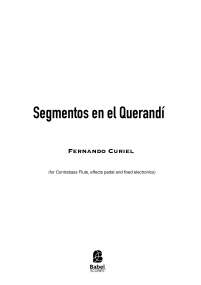Corps
ISMN : 979-0-2325-6510-1
- Login to create your own lists
"This piece was commissioned by Ensemble Intercontemporain in the year 2021, during a time of indefatigueable uncertainty.
It tells two narratives:
- a corps de ballet of Gaga* dancers as they realize the effects of the processes on their individuality, processes of floating, stretching, carving curves/waves/circles/concentric circles, grooving, shaking, quaking, and collapsing.
- a living body and its reactions to the invasion of a foreign entity (perhaps a virus), which is depicted by the piano and percussion jointly. These reactions range from uncomprehending, intuitive, delayed, forceful, violent, appropriative, subtle (or otherwise), etc.
The 12 instruments are still primarily instruments, but as the metaphorical corps de ballet, they function somewhere on the spectrum between a school of fish, a beehive, magnets, a factory, and a flock of swans.
The formal structure of the piece is based on the collision of these two narratives as they run concurrently in linear time. The first section concerns imperceptible changes gradually overtaking the ensemble and changing its DNA, one micro-adjustment at a time. From then on, the piece "naturally selects" itself in a genetic-copying process that happens to coincide structurally with the rigid corps de ballet of classical dancers interacting with the pattern-breaking tenets of Gaga.
The main tension in the piece derives from the binary struggle between the homogeneous ideal and heterogeneous ideal, between extreme chaos and order, between the individual and the many, between the mind and the body, and between the internal environment of flesh and organs and the external entities that seek to colonize or invade it. Perhaps this is because I've been preoccupied lately with the idea of the corpse, bodies in formations, severing space, and being torn or ruptured from the inside out.
While the piece is clearly obsessed with the pitch D, its conclusion, a hard-won switch to a microtonal universe, purposefully avoids it, by means of notable absence: only the upper partials of the overtone series are present, implying a D fundamental that simply doesn't exist sonically. This ending also references the quintessential fade-out technique
of much studio-produced pop music, where the same lyrical verse and instrumental effect is vamped endlessly until it simply stops, never coming to rest or end purposefully on a specific place in the phrase (perhaps the keen listener will be able to hear traces of David Bowie's Space Oddity...), a compelling technique of irresolution surprisingly missing from
the classical canon.
I am extremely grateful to the Ensemble, its director Matthias Pintscher, and the conductor Simon Proust for the opportunity to create this work for them. I hope it proves effective in synthesizing extramusical sources, such as Gaga dance, American techniques of improvisation in vernacular forms, and scientific phenomena serving as social metaphor.
-Maya Miro Johnson
December 4th, 2021
*Gaga is an avant-garde dance form and movement vocabulary originated by Israeli choreographer and dancer Ohad Naharin at the Batsheva Dance Company, which is now practiced by thousands of dancers and non-dancers alike globally."
Pages - 48





